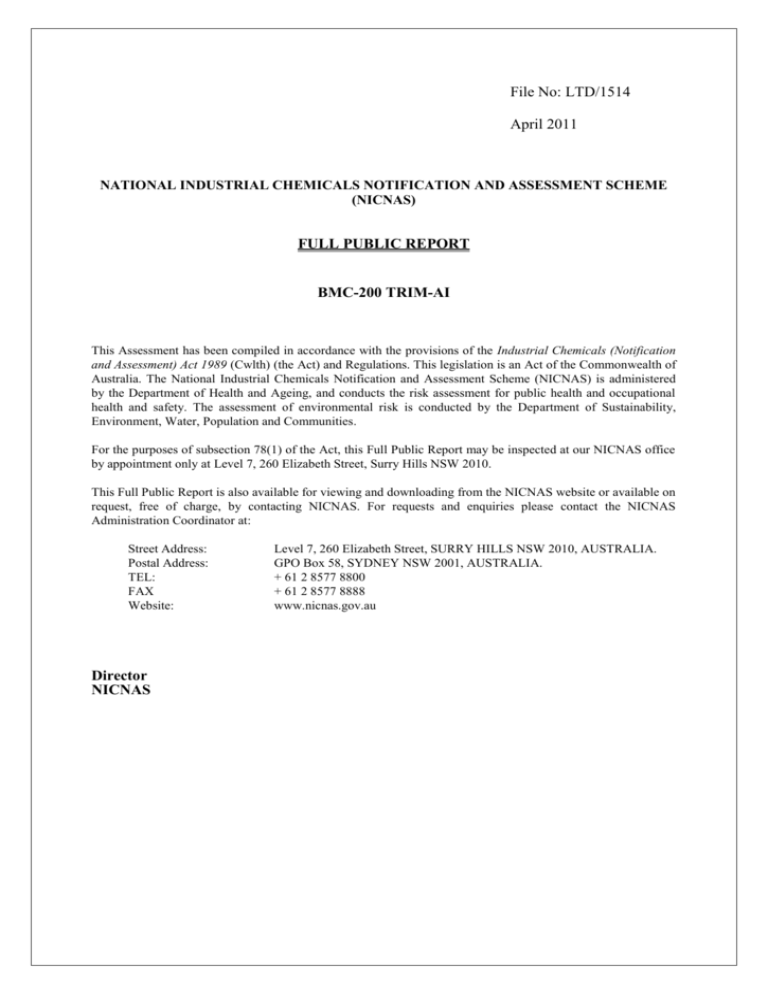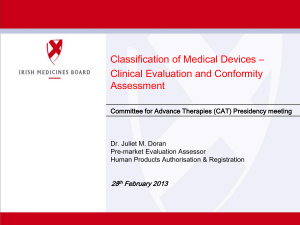LTD/1514
advertisement

File No: LTD/1514 April 2011 NATIONAL INDUSTRIAL CHEMICALS NOTIFICATION AND ASSESSMENT SCHEME (NICNAS) FULL PUBLIC REPORT BMC-200 TRIM-AI This Assessment has been compiled in accordance with the provisions of the Industrial Chemicals (Notification and Assessment) Act 1989 (Cwlth) (the Act) and Regulations. This legislation is an Act of the Commonwealth of Australia. The National Industrial Chemicals Notification and Assessment Scheme (NICNAS) is administered by the Department of Health and Ageing, and conducts the risk assessment for public health and occupational health and safety. The assessment of environmental risk is conducted by the Department of Sustainability, Environment, Water, Population and Communities. For the purposes of subsection 78(1) of the Act, this Full Public Report may be inspected at our NICNAS office by appointment only at Level 7, 260 Elizabeth Street, Surry Hills NSW 2010. This Full Public Report is also available for viewing and downloading from the NICNAS website or available on request, free of charge, by contacting NICNAS. For requests and enquiries please contact the NICNAS Administration Coordinator at: Street Address: Postal Address: TEL: FAX Website: Director NICNAS Level 7, 260 Elizabeth Street, SURRY HILLS NSW 2010, AUSTRALIA. GPO Box 58, SYDNEY NSW 2001, AUSTRALIA. + 61 2 8577 8800 + 61 2 8577 8888 www.nicnas.gov.au TABLE OF CONTENTS FULL PUBLIC REPORT.............................................................................................................................................. 3 1. APPLICANT AND NOTIFICATION DETAILS .................................................................................... 3 2. IDENTITY OF CHEMICAL ................................................................................................................... 3 3. COMPOSITION....................................................................................................................................... 3 4. PHYSICAL AND CHEMICAL PROPERTIES ....................................................................................... 3 5. INTRODUCTION AND USE INFORMATION ..................................................................................... 4 6. HUMAN HEALTH IMPLICATIONS ..................................................................................................... 5 6.1. Exposure Assessment ..................................................................................................................... 5 6.1.1. Occupational Exposure .............................................................................................................. 5 6.1.2. Public Exposure ......................................................................................................................... 5 6.2. Human Health Effects Assessment ................................................................................................. 5 6.3. Human Health Risk Characterisation .............................................................................................. 6 6.3.1. Occupational Health and Safety ................................................................................................. 6 6.3.2. Public Health .............................................................................................................................. 6 7. ENVIRONMENTAL IMPLICATIONS .................................................................................................. 6 7.1. Environmental Exposure & Fate Assessment ................................................................................. 6 7.1.1. Environmental Exposure ............................................................................................................ 6 7.1.2. Environmental Fate .................................................................................................................... 6 7.1.3. Predicted Environmental Concentration (PEC) ......................................................................... 7 7.2. Environmental Effects Assessment ................................................................................................. 7 7.2.1. Predicted No-Effect Concentration ............................................................................................ 7 7.3. Environmental Risk Assessment..................................................................................................... 7 8. CONCLUSIONS AND REGULATORY OBLIGATIONS ..................................................................... 7 APPENDIX A: PHYSICAL AND CHEMICAL PROPERTIES ........................................................................................... 10 BIBLIOGRAPHY ...................................................................................................................................................... 12 April 2011 NICNAS FULL PUBLIC REPORT BMC-200 TRIM-AI 1. APPLICANT AND NOTIFICATION DETAILS APPLICANT(S) Qenos Pty Ltd (ABN: 62 054 196 771) 231-238 Maidstone Street Altona, VIC 3018 NOTIFICATION CATEGORY Limited-small volume: Chemical other than polymer (1 tonne or less per year). EXEMPT INFORMATION (SECTION 75 OF THE ACT) Data items and details claimed exempt from publication: chemical name, other names, CAS number, molecular and structural formulae, molecular weight, analytical data, degree of purity, impurities, additives/adjuvants, use details and import volume. VARIATION OF DATA REQUIREMENTS (SECTION 24 OF THE ACT) Variation to the schedule of data requirements is claimed as follows: water solubility, hydrolysis as a function of pH, partition coefficient, adsorption/desorption and dissociation constant. PREVIOUS NOTIFICATION IN AUSTRALIA BY APPLICANT(S) None NOTIFICATION IN OTHER COUNTRIES None 2. IDENTITY OF CHEMICAL MARKETING NAME(S) PRODIGY(TM) Bimodal Catalyst UT-B2-TRIM-X10 (<10% notified chemical) PRODIGY(TM) UT-B2-TRIM-X10 Bimodal Catalyst PRODIGY(TM) Bimodal Catalyst UT-B2-TRIM PRODIGY(TM) UT-B2-TRIM Bimodal Catalyst UT-TR-200 MOLECULAR WEIGHT <500 Da ANALYTICAL DATA Reference IR and UV spectra were provided. 3. COMPOSITION DEGREE OF PURITY 4. >95% PHYSICAL AND CHEMICAL PROPERTIES APPEARANCE AT 20 ºC AND 101.3 kPa: yellow liquid Property Freezing Point Boiling Point Density Vapour Pressure Water Solubility FULL PUBLIC REPORT: LTD/1514 Value <-20 oC Decomposition at 224 102.12 kPa 1140 kg/m3 at 20 oC 1.4 x 10-6 kPa at 25 oC Not determined o C at Data Source/Justification Measured Measured Measured Measured High reactivity precludes study from being conducted Page 3 of 12 April 2011 NICNAS Hydrolysis as a Function of pH Not determined Partition Coefficient (n-octanol/water) Adsorption/Desorption Not determined Dissociation Constant Not determined Flash Point Flammability (Contact with water) 48 ± 2 oC at 101.325 kPa Hazardous gas evolution >1 L/kg/hour Non-pyrophoric 262 ± 5 oC Non-explosive Predicted negative Not determined Pyrophoric properties Autoignition Temperature Explosive Properties Oxidising Properties High reactivity precludes study from being conducted High reactivity precludes study from being conducted High reactivity precludes study from being conducted High reactivity precludes study from being conducted Measured Measured Measured Measured Measured Contains no functional groups that would imply oxidising properties. DISCUSSION OF PROPERTIES For full details of tests on physical and chemical properties, refer to Appendix A. Reactivity The notified chemical is a catalyst that is flammable and highly reactive with water. It will degrade upon reaction with water, moist air and during end-use. Dangerous Goods classification Based on the submitted physical-chemical data in the above table the notified chemical is classified as follows according to the Australian Dangerous Goods Code (NTC, 2007). Class 4.3 – Substances which in contact with water emit flammable gases (Packing Group III) Sub-class 3 – Flammable liquids The data above do not address all Dangerous Goods endpoints. Therefore, consideration of all endpoints should be undertaken before a final decision on the Dangerous Goods classification is made by the introducer of the chemical. 5. INTRODUCTION AND USE INFORMATION MODE OF INTRODUCTION OF NOTIFIED CHEMICAL (100%) OVER NEXT 5 YEARS The notified chemical will be imported as a solvent solution at <10% concentration. MAXIMUM INTRODUCTION VOLUME OF NOTIFIED CHEMICAL (100%) OVER NEXT 5 YEARS Year Tonnes 1 ≤1 2 ≤1 3 ≤1 4 ≤1 5 ≤1 PORT OF ENTRY Melbourne IDENTITY OF MANUFACTURER/RECIPIENTS Qenos Australia Pty Ltd TRANSPORTATION AND PACKAGING The notified chemical (at <10% concentration) will be supplied in 119 gallon metal containers and transported to the recipient by road. The notified chemical will be stored in the original unopened containers under an inert atmosphere. USE The notified chemical will be used as a catalyst for polyethylene production. OPERATION DESCRIPTION FULL PUBLIC REPORT: LTD/1514 Page 4 of 12 April 2011 NICNAS Upon delivery of the notified chemical (at <10% concentration) to polyethylene production sites, it will be pumped into the polymerization reactor. The notified chemical will be encapsulated into the polyethylene and will be removed from the reactor as part of the polyethylene. The product polyethylene will be transferred to a storage bin for packaging and shipment. Due to the reactive nature of the notified chemical, closed system transfers will be necessary. Prior to line disconnection, the system will be flushed and the residue collected as hazardous waste. Emptied product containers will be returned to the international supplier for cleaning. The polyethylene production unit will be contained in an outdoor environment, i.e. in an unconfined area that is subject to outside ambient conditions and open to the atmosphere. 6. HUMAN HEALTH IMPLICATIONS 6.1. 6.1.1. Exposure Assessment Occupational Exposure EXPOSURE DETAILS Transport and storage workers are unlikely to be exposed to the notified chemical (at <10% concentration) except in the event of an accident. Due to the closed-system operation at the polyethylene production site, exposure of workers to the notified chemical is expected to be minimal. Dermal or ocular exposure to the notified chemical may occur whilst connecting and disconnecting transfer lines. However, exposure should be mitigated through the flushing of the system prior to hose disconnection and through the use of personal protective equipment (PPE: goggles, impervious gloves, protective clothing). 6.1.2. Public Exposure The notified chemical is intended for industrial use only, therefore the public may be exposed to the notified chemical (at <10% concentration) only in the event of a transport accident. The public may come into contact with the manufactured polyethylene. However, as the notified chemical will have reacted and become encapsulated into the polyethylene, it will be unavailable for exposure. 6.2. Human Health Effects Assessment No toxicity data were submitted. The generation of such data is precluded by the high reactivity of the notified chemical with water. The notified chemical is expected to degrade upon reaction with water, air (moist) and during end-use. Therefore, any exposure is expected to be to the degradation products, including metal oxides and hydroxides, and small organic compounds. Some of the degradation products have the following exposure standards (HSIS): Metal oxides and hydroxides: TWA 5 mg/m3; STEL: 10 mg/m3 Small organic compounds: TWA 203 mg/m3; TWA 75 ppm Based on the expected negligible lipophilicity of the inorganic degradation products of the notified chemical, passive diffusion across the gastrointestinal (GI) tract and dermal absorption is unlikely to occur. Absorption of the small organic compounds may occur. The notified chemical and its degradation products do not contain any structural alerts for toxic effects. However, given the high reactivity of the notified chemical, the notifier has classified the chemical as an irritant to eyes, the respiratory system and skin and as a sensitiser. Health hazard classification In the absence of toxicity data, the notified chemical cannot be classified according to the Approved Criteria for Classifying Hazardous Substances (NOHSC, 2004). However, the notifier has classified the chemical with the following risk phrases: R36/37/38 Irritating to eyes, respiratory system and skin FULL PUBLIC REPORT: LTD/1514 Page 5 of 12 April 2011 NICNAS R43 May cause sensitisation by skin contact 6.3. Human Health Risk Characterisation 6.3.1. Occupational Health and Safety The notified chemical will be handled by workers at <10% concentration. The notified chemical itself is classified as a Class 4.3 Dangerous Good (Sub-class 3) according to the Australian Dangerous Goods Code (NTC, 2007), i.e. it emits flammable gases upon contact with water and is a flammable liquid. Transport, storage and handling of products containing the notified chemical in accordance with the above code and the NOHSC National Code of Practice for the Storage and Handling of Workplace dangerous Goods (NOHSC, 2001) should minimise the risk involved for transport and storage workers. The primary risks associated with use of the notified chemical will be due to its reactivity with water. While the reactivity of the chemical precludes toxicological studies from being conducted, the potential for irritation and/or sensitisation effects following contact cannot be excluded. However, given its high reactivity, exposure to the notified chemical itself is expected to be minimal. Given the closed system operation and any volatiles produced will be vented to flare, the expected exposure standards for the degradation products are unlikely to be exceeded. Therefore, provided that control measures are in place to minimise worker exposure, including the use of enclosed/automated processes and PPE, and transport, storage and handling are in accordance with the Dangerous Goods Codes, the risk to the health of workers from use of the notified chemical is not considered to be unacceptable. 6.3.2. Public Health The notified chemical is intended for use in industrial settings by trained workers. The public may be exposed to the manufactured polyethylene. However, the notified chemical will have reacted and become encapsulated into the polyethylene and will be unavailable for exposure. Therefore, when used in the proposed manner, the risk to public health from the notified chemical is not considered to be unacceptable. 7. ENVIRONMENTAL IMPLICATIONS 7.1. Environmental Exposure & Fate Assessment 7.1.1. Environmental Exposure RELEASE OF CHEMICAL AT SITE The notified chemical will be imported into Australia as a component of a finished product in pressure rated metal containers. Accidental spills and leaks during transport are unlikely. However, in the case of an accidental release the notified chemical is expected to be disposed of by a licensed waste contractor. RELEASE OF CHEMICAL FROM USE Empty containers containing residues of the notified chemical will be exported to be cleaned, refurbished and reused. Due to its reactive nature and use in a closed system, release of the notified chemical to the environment during use is expected to be negligible. Line flushes and drainings containing the residues of the notified chemical will be collected and disposed of by a licensed waste contractor. The majority of imported notified chemical will be consumed during the polymerisation process and encapsulated in the manufactured polyethylene. RELEASE OF CHEMICAL FROM DISPOSAL The reacted notified chemical will share the fate of the polyethylene in which it is encapsulated and is expected to be disposed of to landfill. 7.1.2. Environmental Fate No environmental fate data were submitted. Aquatic exposure to the notified chemical is not expected when it is used as proposed in the industrial manufacture of polyethylene. However, if the notified chemical is released to the aquatic environment it will rapidly react to form water, refractory insoluble metal oxides and hydroxides, and small organic molecules. In landfill, the reacted notified chemical will be encapsulated in polyethylene and therefore will not be exposed to the environment. The reacted notified chemical in the polyethylene articles is not likely to be bioavailable nor bioaccumulative and is expected to decompose to form insoluble inorganic compounds and oxides of carbon. FULL PUBLIC REPORT: LTD/1514 Page 6 of 12 April 2011 NICNAS 7.1.3. Predicted Environmental Concentration (PEC) A PEC was not determined because very little of the notified chemical is expected to be released to the aquatic compartment when the chemical is used as proposed in the manufacture of polyethylene. Moreover, the notified chemical is not expected to persist in water due to its reactivity. 7.2. Environmental Effects Assessment No ecotoxicity data for the notified chemical were submitted. On contact with air or water the notified chemical will rapidly react to form refractory insoluble metal oxides and hydroxides, which will therefore be neither bioavailable nor bioaccumulative. 7.2.1. Predicted No-Effect Concentration The PNEC was not calculated as no ecotoxicity data are available for the notified chemical and there is expected to be very little exposure of the notified chemical to the water compartment based on the proposed use pattern. 7.3. Environmental Risk Assessment All spillages and waste containing the notified chemical are expected to be disposed to by licensed waste contractors according to State/Territory regulations. During use, the majority of the notified chemical will be consumed during the polymerisation process and immobilised within a cured inert polymerised polyethylene matrix rendering it unavailable to the environment. On contact with air or water the notified chemical will rapidly react to form refractory insoluble metal oxides and hydroxides, which will therefore be neither bioavailable nor bioaccumulative. Since there is expected to be very limited exposure to aquatic organisms, the notified chemical is therefore not expected to pose an unacceptable risk to the environment based on its proposed use pattern. 8. CONCLUSIONS AND REGULATORY OBLIGATIONS Hazard classification In the absence of toxicity data, the notified chemical cannot be classified according to the Approved Criteria for Classifying Hazardous Substances [NOHSC:1008(2004)]. However, the notifier has classified the chemical with the following risk phrases: R36/37/38 Irritating to eyes, respiratory system and skin R43 May cause sensitisation by skin contact Human health risk assessment Under the conditions of the occupational settings described, the notified chemical is not considered to pose an unacceptable risk to public health. Environmental risk assessment On the basis of the reported use pattern, the notified chemical is not considered to pose an unacceptable risk to the environment. Recommendations REGULATORY CONTROLS Hazard Classification and Labelling The notified chemical should be classified as follows under the ADG Code: Class 4.3 – Substances which in contact with water emit flammable gases (Packing Group III) Sub-class 3 – Flammable liquids As the notified chemical is a dangerous good, the applicant should ensure that the MSDS and labels for products containing the notified chemical are acceptable to the relevant state authority. CONTROL MEASURES Occupational Health and Safety Employers should implement the following engineering controls to minimise occupational exposure to the notified chemical as introduced (<10%): FULL PUBLIC REPORT: LTD/1514 Page 7 of 12 April 2011 NICNAS Enclosed, automated processes Use under an inert atmosphere Employers should implement the following safe work practices to minimise occupational exposure during handling of the notified chemical as introduced (<10%): Avoid contact with skin and eyes Avoid spills and splashing during use Prevent leaks and spills A shower and eyewash station should be available Employers should ensure that the following personal protective equipment is used by workers to minimise occupational exposure to the notified chemical as introduced (<10%): Coveralls, gloves, goggles Guidance in selection of personal protective equipment can be obtained from Australian, Australian/New Zealand or other approved standards. A copy of the MSDS should be easily accessible to employees. If products and mixtures containing the notified chemical are classified as hazardous to health in accordance with the Approved Criteria for Classifying Hazardous Substances [NOHSC:1008(2004)] workplace practices and control procedures consistent with provisions of State and Territory hazardous substances legislation must be in operation. Disposal The notified chemical should be disposed of to landfill. Storage The following precautions should be taken by storage managers regarding storage of the notified chemical as introduced: Store in original unopened container under an inert atmosphere. The handling and storage of the notified chemical should be in accordance with the NOHSC National Code of Practice for the Storage and Handling of Workplace dangerous Goods [NOHSC:2017(2001)] or relevant State or Territory regulations. Emergency procedures Spills or accidental release of the notified chemical should be handled by physical containment, collection and subsequent safe disposal. In the event of an emergency, unnecessary personnel should be evacuated and all ignition sources removed. Transport and Packaging The transportation of the notified chemical should be in accordance with the Australian Code for the Transport of Dangerous Goods by Road and Rail (ADG code) (NTC, 2007). Regulatory Obligations Secondary Notification This risk assessment is based on the information available at the time of notification. The Director may call for the reassessment of the chemical under secondary notification provisions based on changes in certain circumstances. Under Section 64 of the Industrial Chemicals (Notification and Assessment) Act (1989) the FULL PUBLIC REPORT: LTD/1514 Page 8 of 12 April 2011 NICNAS notifier, as well as any other importer or manufacturer of the notified chemical, have post-assessment regulatory obligations to notify NICNAS when any of these circumstances change. These obligations apply even when the notified chemical is listed on the Australian Inventory of Chemical Substances (AICS). Therefore, the Director of NICNAS must be notified in writing within 28 days by the notifier, other importer or manufacturer: (1) Under Section 64(1) of the Act; if the importation volume exceeds one tonne per annum notified chemical; or (2) Under Section 64(2) of the Act; if the function or use of the chemical has changed from a catalyst for polyethylene production, or is likely to change significantly; the chemical has begun to be manufactured in Australia; additional information has become available to the person as to an adverse effect of the chemical on occupational health and safety, public health, or the environment. The Director will then decide whether a reassessment (i.e. a secondary notification and assessment) is required. Material Safety Data Sheet The MSDS of a product containing the notified chemical provided by the notifier was reviewed by NICNAS. The accuracy of the information on the MSDS remains the responsibility of the applicant. FULL PUBLIC REPORT: LTD/1514 Page 9 of 12 April 2011 NICNAS APPENDIX A: PHYSICAL AND CHEMICAL PROPERTIES Melting Point/Freezing Point Method Remarks Test Facility EC Directive 92/69/EEC A.1 Melting/Freezing Temperature. Determined by cooling a tube containing the sample in a dry ice/acetone bath Harlan (2010a) Boiling Point Method Remarks Test Facility Decomposition at 224 oC at 102.12 kPa EC Directive 92/69/EEC A.2 Boiling Temperature. Determined by differential scanning calorimetry (DSC). As the test substance decomposed, no value for boiling point was determined. Harlan (2010a) Density Method Remarks Test Facility 1140 kg/m3 at 20 oC EC Directive 92/69/EEC A.3 Relative Density. Determined using a pycnometer. Harlan (2010a) Vapour Pressure Method Remarks Test Facility 1.4 x 10-6 kPa at 25 oC EC Directive 92/69/EEC A.4 Vapour Pressure. Determined using a vapour pressure balance Harlan (2010b) Flash Point Method Remarks Test Facility 48 ± 2 oC at 101.325 kPa EC Directive 92/69/EEC A.9 Flash Point. Determined using a closed cup equilibrium method. Harlan (2010b) Flammability Method Remarks Test Facility Hazardous, gas evolution >1 L/kg/hour EC Directive 92/69/EEC A.12 Flammability (Contact with Water). The test substance was subjected to water/dampness and observations made for evolution of gas. The gas evolved was methane. Harlan (2010b) Autoignition Temperature Method Remarks Test Facility Test Facility 262 ± 5 oC EC Directive 92/69/EEC A.15 Auto-Ignition Temperature (Liquids and Gases). Determined by heating aliquots of the test material in a flask and observing any ignition Harlan (2010b) Pyrophoric Properties Method Remarks <-20 oC Non-pyrophoric EC Directive 92/69/EEC A.13 Pyrophoric Properties of Solids and Liquids Determined by observing for signs of ignition after pouring the test substance onto diatomaceous earth and dried filter paper. Harlan (2010b) Explosive Properties Non-explosive Method Remarks EC Directive 92/69/EEC A.14 Explosive Properties. The test substance was subjected to the BAM fall hammer test (mechanical sensitivity with respect to shock) and Kroenen steel tube test (thermal sensitivity) Test Facility Harlan (2010b) Predicted negative Oxidizing Properties FULL PUBLIC REPORT: LTD/1514 Page 10 of 12 April 2011 Method Remarks Test Facility NICNAS EC Directive 92/69/EEC A.21 Oxidizing Properties (Liquids). The structure was assessed for functional groups that would infer oxidising properties. Harlan (2009d) FULL PUBLIC REPORT: LTD/1514 Page 11 of 12 April 2011 NICNAS BIBLIOGRAPHY Harlan (2010a) (Notified chemical) Determination of General Physico-Chemical Properties (Project number: 3200/0001, August, 2010), Derbyshire, U.K., Harlan Laboratories Limited (Unpublished report submitted by the notifier). Harlan (2010b) (Notified chemical) Determination of Hazardous Physico-Chemical Properties (Project number: 3200/0002, September, 2010), Derbyshire, U.K., Harlan Laboratories Limited (Unpublished report submitted by the notifier). NOHSC (1994) National Code of Practice for the Labelling of Workplace Substances [NOHSC:2012(1994)]. National Occupational Health and Safety Commission, Canberra, Australian Government Publishing Service. NOHSC (2001) National Code of Practice for the Storage and Handling of Workplace Dangerous Goods [NOHSC:2017(2001)]. National Occupational Health and Safety Commission, Canberra, Australian Government Publishing Service. NOHSC (2003) National Code of Practice for the Preparation of Material Safety Data Sheets, 2 nd edition [NOHSC:2011(2003)]. National Occupational Health and Safety Commission, Canberra, Australian Government Publishing Service. NOHSC (2004) Approved Criteria for Classifying Hazardous Substances, 3 rd edition [NOHSC:1008(2004)]. National Occupational Health and Safety Commission, Canberra, AusInfo. NTC (National Transport Commission) 2007 Australian Code for the Transport of Dangerous Goods by Road and Rail (ADG code), 7th Edition, Commonwealth of Australia FULL PUBLIC REPORT: LTD/1514 Page 12 of 12




